《通信原理实验》课程电子教案(讲稿)MATLAB与通信仿真(英文)Chapter 7 Spread Spectrum Communication Systems
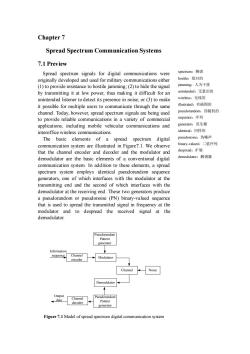
Chapter 7 Spread Spectrum Communication Systems 7.1 Preview Spread spectrum signals for digital communications were spectrum:频谱 originally developed and used for military communications either hostile:敌对的 (1)to provide resistance to hostile jamming;(2)to hide the signal jamming:人为干扰 by transmitting it at low power,thus making it difficult for an unintended:无意识的 unintended listener to detect its presence in noise;or(3)to make wireless:无线的 it possible for multiple users to communicate through the same illustrated:有插图的 channel.Today,however,spread spectrum signals are being used pseudorandom:伪随机的 to provide reliable communications in a variety of commercial sequence:序列 applications,including mobile vehicular communications and generator:发生器 interoffice wireless communications. identical:同样的 The basic elements of a spread spectrum digital pseudonoise:伪噪声 communication system are illustrated in Figure7.1.We observe binary-valued:二值序列 that the channel encoder and decoder and the modulator and despread:扩展 demodulator are the basic elements of a conventional digital demodulator:解调器 communication system.In addition to these elements,a spread spectrum system employs identical pseudorandom sequence generators,one of which interfaces with the modulator at the transmitting end and the second of which interfaces with the demodulator at the receiving end.These two generators produce a pseudorandom or pseudonoise (PN)binary-valued sequence that is used to spread the transmitted signal in frequency at the modulator and to despread the received signal at the demodulator. Pseudorandom Pattern generator Information sequence Channel Modulator encoder Channel Noise Demodulator Output Channel Pseudorandom data decoder Pattern generator Figure 7.1 Model of spread spectrum digital communication system
Chapter 7 Spread Spectrum Communication Systems 7.1 Preview Spread spectrum signals for digital communications were originally developed and used for military communications either (1) to provide resistance to hostile jamming; (2) to hide the signal by transmitting it at low power, thus making it difficult for an unintended listener to detect its presence in noise; or (3) to make it possible for multiple users to communicate through the same channel. Today, however, spread spectrum signals are being used to provide reliable communications in a variety of commercial applications, including mobile vehicular communications and interoffice wireless communications. The basic elements of a spread spectrum digital communication system are illustrated in Figure7.1. We observe that the channel encoder and decoder and the modulator and demodulator are the basic elements of a conventional digital communication system. In addition to these elements, a spread spectrum system employs identical pseudorandom sequence generators, one of which interfaces with the modulator at the transmitting end and the second of which interfaces with the demodulator at the receiving end. These two generators produce a pseudorandom or pseudonoise (PN) binary-valued sequence that is used to spread the transmitted signal in frequency at the modulator and to despread the received signal at the demodulator. Channel encoder Channel Modulator Noise Demodulator Channel decoder Pseudorandom Pattern generator Pseudorandom Pattern generator Information sequence Output data Figure 7.1 Model of spread spectrum digital communication system spectrum:频谱 hostile:敌对的 jamming:人为干扰 unintended:无意识的 wireless:无线的 illustrated:有插图的 pseudorandom:伪随机的 sequence:序列 generator:发生器 identical:同样的 pseudonoise:伪噪声 binary-valued:二值序列 despread:扩展 demodulator:解调器
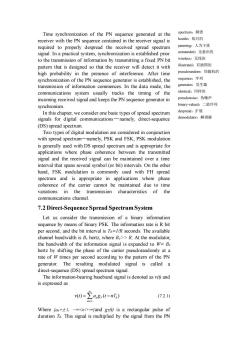
Time synchronization of the PN sequence generated at the spectrum:频谱 receiver with the PN sequence contained in the receiver signal is hostile:敌对的 required to properly despread the received spread spectrum jamming:人为千扰 signal.In a practical system,synchronization is established prior unintended:无意识的 to the transmission of information by transmitting a fixed PN bit wireless:.无线的 pattern that is designed so that the receiver will detect it with llustrated:有插图的 high probability in the presence of interference.After time pseudorandom:伪随机的 synchronization of the PN sequence generator is established,the sequence:序列 transmission of information commences.In the data mode,the generator:发生器 communications system usually tracks the timing of the identical:同样的 incoming received signal and keeps the PN sequence generator in pseudonoise:伪噪声 synchronism. binary-valued:二值序列 In this chapter,we consider one basic types of spread spectrum despread:扩展 signals for digital communications-namely,direct-sequence demodulator:解调器 (DS)spread spectrum. Two types of digital modulation are considered in conjunction with spread spectrum-namely,PSK and FSK,PSK modulation is generally used with DS spread spectrum and is appropriate for applications where phase coherence between the transmitted signal and the received signal can be maintained over a time interval that spans several symbol (or bit)intervals.On the other hand,FSK modulation is commonly used with FH spread spectrum and is appropriate in applications where phase coherence of the carrier cannot be maintained due to time variations in the transmission characteristics of the communications channel. 7.2 Direct-Sequence Spread Spectrum System Let us consider the transmission of a binary information sequence by means of binary PSK.The information rate is R bit per second,and the bit interval is T=1/R seconds.The available channel bandwidth is Be hertz,where Be>>R.At the modulator, the bandwidth of the information signal is expanded to W=Be hertz by shifting the phase of the carrier pseudorandomly at a rate of W times per second according to the pattern of the PN generator.The resulting modulated signal is called a direct-sequence(DS)spread spectrum signal. The information-bearing baseband signal is denoted as v and is expressed as 0=2a,8,-n7) (7.2.10 Where fan=+1,-n+and gr(t)is a rectangular pulse of duration T.This signal is multiplied by the signal from the PN
Time synchronization of the PN sequence generated at the receiver with the PN sequence contained in the receiver signal is required to properly despread the received spread spectrum signal. In a practical system, synchronization is established prior to the transmission of information by transmitting a fixed PN bit pattern that is designed so that the receiver will detect it with high probability in the presence of interference. After time synchronization of the PN sequence generator is established, the transmission of information commences. In the data mode, the communications system usually tracks the timing of the incoming received signal and keeps the PN sequence generator in synchronism. In this chapter, we consider one basic types of spread spectrum signals for digital communications—namely, direct-sequence (DS) spread spectrum. Two types of digital modulation are considered in conjunction with spread spectrum—namely, PSK and FSK, PSK modulation is generally used with DS spread spectrum and is appropriate for applications where phase coherence between the transmitted signal and the received signal can be maintained over a time interval that spans several symbol (or bit) intervals. On the other hand, FSK modulation is commonly used with FH spread spectrum and is appropriate in applications where phase coherence of the carrier cannot be maintained due to time variations in the transmission characteristics of the communications channel. 7.2 Direct-Sequence Spread Spectrum System Let us consider the transmission of a binary information sequence by means of binary PSK. The information rate is R bit per second, and the bit interval is Tb=1/R seconds. The available channel bandwidth is Bc hertz, where Bc>> R. At the modulator, the bandwidth of the information signal is expanded to W= Bc hertz by shifting the phase of the carrier pseudorandomly at a rate of W times per second according to the pattern of the PN generator. The resulting modulated signal is called a direct-sequence (DS) spread spectrum signal. The information-bearing baseband signal is denoted as v(t) and is expressed as ( ) ( ) n T b n v t a g t nT = = − (7.2.1) Where {an=±1, -∞<n<+∞}and gT(t) is a rectangular pulse of duration Tb. This signal is multiplied by the signal from the PN spectrum:频谱 hostile:敌对的 jamming:人为干扰 unintended:无意识的 wireless:无线的 illustrated:有插图的 pseudorandom:伪随机的 sequence:序列 generator:发生器 identical:同样的 pseudonoise:伪噪声 binary-valued:二值序列 despread:扩展 demodulator:解调器
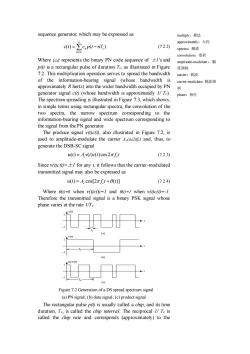
sequence generator,which may be expressed as multiply:乘法 dt)=Ec.p(t-nT.) approximately:大约 (7.2.2) spectra:频谱 convolution:卷积 Where fcn represents the binary PN code sequence of +l's and amplitude-modulate: p is a rectangular pulse of duration Te,as illustrated in Figure 度调制 7.2.This multiplication operation serves to spread the bandwidth carrier:载波 of the information-bearing signal (whose bandwidth is carrier-modulate:载波调 approximately R hertz)into the wider bandwidth occupied by PN 制 generator signal c(t)(whose bandwidth is approximately 1/T) phase:相位 The spectrum spreading is illustrated in Figure 7.3,which shows, in simple terms using rectangular spectra,the convolution of the two spectra,the narrow spectrum corresponding to the information-bearing signal and wide spectrum corresponding to the signal from the PN generator. The produce signal vct),also illustrated in Figure 7.2,is used to amplitude-modulate the carrier A cos2zf and,thus,to generate the DSB-SC signal u(1)=Av(t)c(t)cos2zft (7.2.3) Since v(c)=I for any t,it follows that the carrier-modulated transmitted signal may also be expressed as u(t)=A.cos[2πf1+θt)] (7.2.4) Where 0t)=0 when v(t)c(()=1 and et)=1 when v(t)c(()=-1. Therefore the transmitted signal is a binary PSK signal whose phase varies at the rate 1/Tc. (a】 v(t) (b) c(t)v(t) (c) Figure 7.2 Generation of a DS spread spectrum signal (a)PN signal;(b)data signal;(c)product signal The rectangular pulse p is usually called a chip,and its time duration,Te,is called the chip interval.The reciprocal 1/Te is called the chip rate and corresponds (approximately)to the
sequence generator, which may be expressed as ( ) ( ) n c n c t c p t nT = = − (7.2.2) Where {cn} represents the binary PN code sequence of ±1’s and p(t) is a rectangular pulse of duration Tc, as illustrated in Figure 7.2. This multiplication operation serves to spread the bandwidth of the information-bearing signal (whose bandwidth is approximately R hertz) into the wider bandwidth occupied by PN generator signal c(t) (whose bandwidth is approximately 1/ Tc). The spectrum spreading is illustrated in Figure 7.3, which shows, in simple terms using rectangular spectra, the convolution of the two spectra, the narrow spectrum corresponding to the information-bearing signal and wide spectrum corresponding to the signal from the PN generator. The produce signal v(t)c(t), also illustrated in Figure 7.2, is used to amplitude-modulate the carrier Accos2πfct and, thus, to generate the DSB-SC signal ( ) ( ) ( )cos2 c c u t A v t c t f t = (7.2.3) Since v(t)c(t)=±1 for any t, it follows that the carrier-modulated transmitted signal may also be expressed as ( ) cos[2 ( )] c c u t A f t t = + (7.2.4) Where (t)=0 when v(t)c(t)=1 and (t)=1 when v(t)c(t)=-1. Therefore the transmitted signal is a binary PSK signal whose phase varies at the rate 1/Tc. 1 -1 1 -1 1 -1 t t t c(t) v(t) c(t)v(t) Tc Tb Tb (a) (b) (c) Figure 7.2 Generation of a DS spread spectrum signal (a) PN signal; (b) data signal; (c) product signal The rectangular pulse p(t) is usually called a chip, and its time duration, Tc, is called the chip interval. The reciprocal 1/ Tc is called the chip rate and corresponds (approximately) to the multiply:乘法 approximately:大约 spectra:频谱 convolution:卷积 amplitude-modulate: 幅 度调制 carrier:载波 carrier-modulate:载波调 制 phase:相位
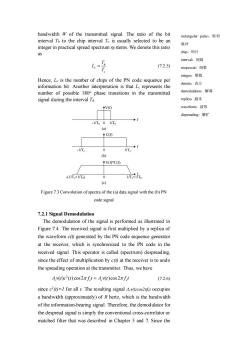
band width W of the transmitted signal.The ratio of the bit rectangular pulse:矩形 interval Toto the chip interval Te is usually selected to be an 脉冲 integer in practical spread spectrum systems.We denote this ratio as chip:码片 interval::间隔 L.= (7.2.5) reciprocal:倒数 integer:整数 Hence,Lc is the number of chips of the PN code sequence per denote:表示 information bit.Another interpretation is that Le represents the number of possible 180 phase transitions in the transmitted demodulation:解调 signal during the interval To. replica:副本 ◆V(f waveform:波形 dispreading:解扩 f -1T601/Tb (a) 个C() →f -1/Tc 0 I/T (b) 个V(*C() -(1/T+1/T6) 0 1/T+ITb (c) Figure 7.3 Convolution of spectra of the (a)data signal with the(b)PN code signal 7.2.1 Signal Demodulation The demodulation of the signal is performed as illustrated in Figure 7.4.The received signal is first multiplied by a replica of the waveform ct)generated by the PN code sequence generator at the receiver,which is synchronized to the PN code in the received signal.This operator is called(spectrum)despreading, since the effect of multiplication by ct)at the receiver is to undo the spreading operation at the transmitter.Thus,we have Av(t)c2(t)cos2πft=A.v(t)cos2πft (7.2.6 since c2t)=I for all t.The resulting signal Aev(t)cos2zfet occupies a bandwidth(approximately)of R hertz,which is the bandwidth of the information-bearing signal.Therefore,the demodulator for the despread signal is simply the conventional cross-correlator or matched filter that was described in Chapter 5 and 7.Since the
bandwidth W of the transmitted signal. The ratio of the bit interval Tb to the chip interval Tc is usually selected to be an integer in practical spread spectrum systems. We denote this ratio as b c c T L T = (7.2.5) Hence, Lc is the number of chips of the PN code sequence per information bit. Another interpretation is that Lc represents the number of possible 180o phase transitions in the transmitted signal during the interval Tb. (c) (b) (a) f f f V(f) C(f) V(f)*C(f) -1/Tb 0 1/Tb -1/Tc 0 1/Tc -(1/Tc+1/Tb) 0 1/Tc+1/Tb Figure 7.3 Convolution of spectra of the (a) data signal with the (b) PN code signal 7.2.1 Signal Demodulation The demodulation of the signal is performed as illustrated in Figure 7.4. The received signal is first multiplied by a replica of the waveform c(t) generated by the PN code sequence generator at the receiver, which is synchronized to the PN code in the received signal. This operator is called (spectrum) despreading, since the effect of multiplication by c(t) at the receiver is to undo the spreading operation at the transmitter. Thus, we have 2 ( ) ( )cos 2 ( )cos 2 A v t c t f t A v t f t c c c c = (7.2.6) since c 2 (t)=1 for all t. The resulting signal Acv(t)cos2πfct occupies a bandwidth (approximately) of R hertz, which is the bandwidth of the information-bearing signal. Therefore, the demodulator for the despread signal is simply the conventional cross-correlator or matched filter that was described in Chapter 5 and 7. Since the rectangular pulse:矩形 脉冲 chip:码片 interval:间隔 reciprocal:倒数 integer:整数 denote:表示 demodulation:解调 replica:副本 waveform:波形 dispreading:解扩
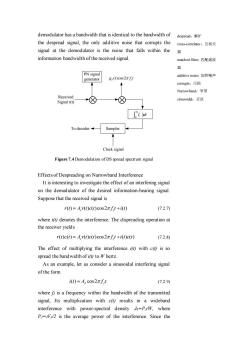
demodulator has a bandwidth that is identical to the bandwidth of despread:解扩 the despread signal,the only additive noise that corrupts the cross-correlator:互相关 signal at the demodulator is the noise that falls within the 0 information bandwidth of the received signal. matched filter:匹配滤波 器 PN signal additive noise:加性噪声 generator 8r(t)cos2πf1 corrupts:污损 Narrowband:窄带 Received sinusoidal:正弦 Signal r(t) (h To decoder Sampler Clock signal Figure 7.4 Demodulation of DS spread spectrum signal Effects of Despreading on Narrowband Interference It is interesting to investigate the effect of an interfering signal on the demodulator of the desired information-bearing signal. Suppose that the received signal is r(t)=A.v(t)c(t)cos2nft+i(t) (7.2.7) where it)denotes the interference.The dispreading operation at the receiver yields r(t)c(1)=Av(t)c(t)cos2nft+i(t)c(t) (7.2.8) The effect of multiplying the interference it)with c is so spread the band width of ift)to W hertz. As an example,let us consider a sinusoidal interfering signal of the form i(t)=Acos2πfj1 (7.2.9) where f is a frequency within the bandwidth of the transmitted signal,Its multiplication with ct)results in a wideband interference with power-spectral density Jo=P//W,where PJ=A21/2 is the average power of the interference.Since the
demodulator has a bandwidth that is identical to the bandwidth of the despread signal, the only additive noise that corrupts the signal at the demodulator is the noise that falls within the information bandwidth of the received signal. Sampler PN signal generator Received Signal r(t) ( )cos 2 T c g t f t Clock signal To decoder ( ) 0 Ts dt Figure 7.4 Demodulation of DS spread spectrum signal Effects of Despreading on Narrowband Interference It is interesting to investigate the effect of an interfering signal on the demodulator of the desired information-bearing signal. Suppose that the received signal is ( ) ( ) ( )cos 2 ( ) c c r t A v t c t f t i t = + (7.2.7) where i(t) denotes the interference. The dispreading operation at the receiver yields ( ) ( ) ( ) ( )cos2 ( ) ( ) c c r t c t A v t c t f t i t c t = + (7.2.8) The effect of multiplying the interference i(t) with c(t) is so spread the bandwidth of i(t) to W hertz. As an example, let us consider a sinusoidal interfering signal of the form ( ) cos 2 J J i t A f t = (7.2.9) where fJ is a frequency within the bandwidth of the transmitted signal, Its multiplication with c(t) results in a wideband interference with power-spectral density J0=PJ/W, where PJ=A2 J/2 is the average power of the interference. Since the despread:解扩 cross-correlator:互相关 器 matched filter:匹配滤波 器 additive noise:加性噪声 corrupts:污损 Narrowband:窄带 sinusoidal:正弦
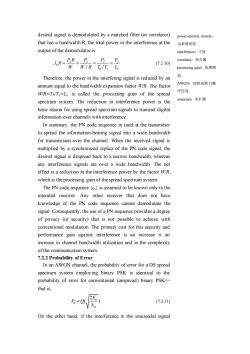
desired signal is demodulated by a matched filter (or correlator) power-spectral density: that has a band width R,the total power in the interference at the 功率普密度 output of the demodulator is interference:千扰 J,R=P-£=E-£ correlator:相关器 W=w1R/T可 (7.2.10) processing gain:处理增 益 Therefore,the power in the interfering signal is reduced by an AWGN:加性高斯白噪 amount equal to the bandwidth expansion factor WR.The factor WR=T/T=Le is called the processing gain of the spread 声信道 spectrum system.The reduction in interference power is the unspread:未扩频 basic reason for using spread spectrum signals to transmit digital information over channels with interference. In summary,the PN code sequence in used at the transmitter to spread the information-bearing signal into a wide bandwidth for transmission over the channel.When the received signal is multiplied by a synchronized replica of the PN code signal,the desired signal is despread back to a narrow bandwidth,whereas any interference signals are over a wide bandwidth.The net effect is a reduction in the interference power by the factor WR, which is the processing gain of the spread spectrum system. The PN code sequence (c;is assumed to be known only to the intended receiver.Any other receiver that does not have knowledge of the PN code sequence cannot demodulate the signal.Consequently,the use of a PN sequence provides a degree of privacy (or security)that is not possible to achieve with conventional modulation.The primary cost for this security and performance gain against interference is an increase is an increase in channel bandwidth utilization and in the complexity of the communication system. 7.2.2 Probability of Error In an AWGN channel,the probability of error for a DS spread spectrum system employing binary PSK is identical to the probability of error for conventional (unspread)binary PSK- that is, P=9 (7.2.11) On the other hand,if the interference is the sinusoidal signal
desired signal is demodulated by a matched filter (or correlator) that has a bandwidth R, the total power in the interference at the output of the demodulator is 0 / / J J J J b c c P R P P P J R W W R T T L = = = = (7.2.10) Therefore, the power in the interfering signal is reduced by an amount equal to the bandwidth expansion factor W/R. The factor W/R=Tb/Tc=Lc is called the processing gain of the spread spectrum system. The reduction in interference power is the basic reason for using spread spectrum signals to transmit digital information over channels with interference. In summary, the PN code sequence in used at the transmitter to spread the information-bearing signal into a wide bandwidth for transmission over the channel. When the received signal is multiplied by a synchronized replica of the PN code signal, the desired signal is despread back to a narrow bandwidth, whereas any interference signals are over a wide bandwidth. The net effect is a reduction in the interference power by the factor W/R, which is the processing gain of the spread spectrum system. The PN code sequence {cn} is assumed to be known only to the intended receiver. Any other receiver that does not have knowledge of the PN code sequence cannot demodulate the signal. Consequently, the use of a PN sequence provides a degree of privacy (or security) that is not possible to achieve with conventional modulation. The primary cost for this security and performance gain against interference is an increase is an increase in channel bandwidth utilization and in the complexity of the communication system. 7.2.2 Probability of Error In an AWGN channel, the probability of error for a DS spread spectrum system employing binary PSK is identical to the probability of error for conventional (unspread) binary PSK— that is, 0 2 ( ) b b E P Q N = (7.2.11) On the other hand, if the interference is the sinusoidal signal power-spectral density: 功率普密度 interference:干扰 correlator:相关器 processing gain:处理增 益 AWGN:加性高斯白噪 声信道 unspread:未扩频
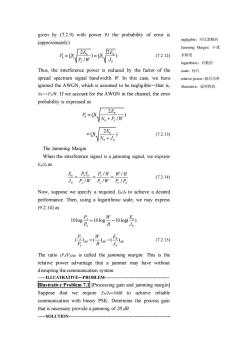
given by (7.2.9)with power PJ the probability of error is (approximately) negligible:可以忽略的 Jamming Margin:干扰 P,=( 2E6)=0、 2EB) (7.2.12) 余裕度 P/W J。 logarithmic:对数的 Thus,the interference power is reduced by the factor of the scale:标尺 spread spectrum signal bandwidth W.In this case,we have relative power:相对功率 ignored the AWGN,which is assumed to be negligible-that is, lustrative:说明性的 No<<P/W.If we account for the AWGN in the channel,the error probability is expressed as P,=O( 2Ep N。+P/W (7.2.13) N+Jo The Jamming Margin When the interference signal is a jamming signal,we express Ew/Jo as E.=PT=B/R_WIR (7.2.14) J。P1WP1WP1P Now,suppose we specify a required Eo to achieve a desired performance.Then,using a logarithmic scale,we may express (9.2.14)as P=10log R 10log Ps gW-101og(5) W (7.2.15) Ps The ratio (P//Ps)aB is called the jamming margin.This is the relative power advantage that a jammer may have without disrupting the communication system. -ILLUATRATIVE-PROBLEM- Illustrative Problem 7.1 [Processing gain and jamming margin] Suppose that we require E//o=10dB to achieve reliable communication with binary PSK.Determine the process gain that is necessary provide a jamming of 20 dB. -SOLUTION-
given by (7.2.9) with power PJ the probability of error is (approximately) 0 2 2 ( ) ( ) / b b b J E E P Q Q P W J = = (7.2.12) Thus, the interference power is reduced by the factor of the spread spectrum signal bandwidth W. In this case, we have ignored the AWGN, which is assumed to be negligible—that is, N0<<PJ/W. If we account for the AWGN in the channel, the error probability is expressed as 0 2 ( ) / b b J E P Q N P W = + 0 0 2 ( ) Eb Q N J = + (7.2.13) The Jamming Margin When the interference signal is a jamming signal, we express Eb/J0 as 0 / / /// b S b S J J J S E P T P R W R J P W P W P P === (7.2.14) Now, suppose we specify a required Eb/J0 to achieve a desired performance. Then, using a logarithmic scale, we may express (9.2.14) as 0 10log 10log 10log( ) J b S P E W P R J = − 0 ( ) ( ) ( ) J b dB dB dB S P E W P R J = − (7.2.15) The ratio (PJ/PS)dB is called the jamming margin. This is the relative power advantage that a jammer may have without disrupting the communication system. -ILLUATRATIVE—PROBLEM- Illustrative Problem 7.1 [Processing gain and jamming margin] Suppose that we require Eb/J0=10dB to achieve reliable communication with binary PSK. Determine the process gain that is necessary provide a jamming of 20 dB. -SOLUTION- negligible:可以忽略的 Jamming Margin:干扰 余裕度 logarithmic:对数的 scale:标尺 relative power:相对功率 illustrative:说明性的
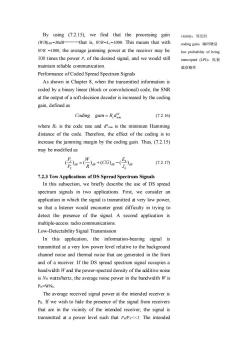
By using (7.2.15),we find that the processing gain vicinity:邻近的 (W/R)aB=30dB-that is,W/R=Le=1000.This means that with coding gain:编码增益 W/R =1000,the average jamming power at the receiver may be low probability of being 100 times the power P,of the desired signal,and we would still intercepted(LPI:低被 maintain reliable communication. 截获概率 Performance of Coded Spread Spectrum Signals As shown in Chapter 8,when the transmitted information is coded by a binary linear(block or convolutional)code,the SNR at the output of a soft-decision decoder is increased by the coding gain,defined as Coding gain=R.d (7.2.16) where Re is the code rate and d"min is the minimum Hamming distance of the code.Therefore,the effect of the coding is to increase the jamming margin by the coding gain.Thus,(7.2.15) may be modified as (e=(发a+(cGa-a (7.2.17) 7.2.3 Tow Applications of DS Spread Spectrum Signals In this subsection,we briefly describe the use of DS spread spectrum signals in two applications.First,we consider an application in which the signal is transmitted at very low power, so that a listener would encounter great difficulty in trying to detect the presence of the signal.A second application is multiple-access radio communications. Low-Detectability Signal Transmission In this application,the information-bearing signal is transmitted at a very low power level relative to the background channel noise and thermal noise that are generated in the front and of a receiver.If the DS spread spectrum signal occupies a band width W and the power-spectral density of the additive noise is No watts/hertz,the average noise power in the bandwidth W is PN=WNo. The average received signal power at the intended receiver is PR.If we wish to hide the presence of the signal from receivers that are in the vicinity of the intended receiver,the signal is transmitted at a power level such that PP<<I.The intended
By using (7.2.15), we find that the processing gain (W/R)dB=30dB———that is, W/R=Lc=1000. This means that with W/R =1000, the average jamming power at the receiver may be 100 times the power Ps of the desired signal, and we would still maintain reliable communication. Performance of Coded Spread Spectrum Signals As shown in Chapter 8, when the transmitted information is coded by a binary linear (block or convolutional) code, the SNR at the output of a soft-decision decoder is increased by the coding gain, defined as min H Coding gain R d = c (7.2.16) where Rc is the code rate and d H min is the minimum Hamming distance of the code. Therefore, the effect of the coding is to increase the jamming margin by the coding gain. Thus, (7.2.15) may be modified as 0 ( ) ( ) ( ) ( ) J b dB dB dB dB S P E W CG P R J = + − (7.2.17) 7.2.3 Tow Applications of DS Spread Spectrum Signals In this subsection, we briefly describe the use of DS spread spectrum signals in two applications. First, we consider an application in which the signal is transmitted at very low power, so that a listener would encounter great difficulty in trying to detect the presence of the signal. A second application is multiple-access radio communications. Low-Detectability Signal Transmission In this application, the information-bearing signal is transmitted at a very low power level relative to the background channel noise and thermal noise that are generated in the front and of a receiver. If the DS spread spectrum signal occupies a bandwidth W and the power-spectral density of the additive noise is N0 watts/hertz, the average noise power in the bandwidth W is PN=WN0. The average received signal power at the intended receiver is PR. If we wish to hide the presence of the signal from receivers that are in the vicinity of the intended receiver, the signal is transmitted at a power level such that PR/PN<<1. The intended vicinity:邻近的 coding gain:编码增益 low probability of being intercepted (LPI):低被 截获概率
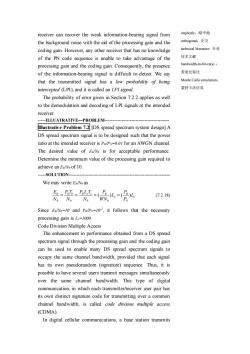
receiver can recover the weak information-bearing signal from implicitly:暗中地 the background noise with the aid of the processing gain and the orthogonal:正交 coding gain.However,any other receiver that has no knowledge technical literature:专业 of the PN code sequence is unable to take advantage of the 技术文献 processing gain and the coding gain.Consequently,the presence bandwidth-to-bit-ratio of the information-bearing signal is difficult to detect.We say 带宽比特比 that the transmitted signal has a low probability of being Monte Carlo simulation: intercepted (LPI),and it is called an LPI signal. 蒙特卡洛仿真 The probability of error given in Section 7.2.2 applies as well to the demodulation and decoding of LPI signals at the intended receiver. -ILLUATRATIVE-PROBLEM- Illustrative Problem 7.2[DS spread spectrum system design]A DS spread spectrum signal is to be designed such that the power ratio at the intended receiver is PR/PN=0.0/for an AWGN channel. The desired value of E/No is for acceptable performance. Determine the minimum value of the processing gain required to achieve an E/No of 10. -SOLUTION- We may write E/No as 是兴=流北-会4 (7.2.18) N。N。N。WN。' Since E/No=10 and PR/PN=102,it follows that the necessary processing gain is L.=1000. Code Division Multiple Access The enhancement in performance obtained from a DS spread spectrum signal through the processing gain and the coding gain can be used to enable many DS spread spectrum signals to occupy the same channel bandwidth,provided that each signal has its own pseudorandom (signature)sequence.Thus,it is possible to have several users transmit messages simultaneously over the same channel bandwidth.This type of digital communication,in which each transmitter/receiver user pair has its own distinct signature code for transmitting over a common channel bandwidth,is called code division multiple access (CDMA). In digital cellular communications,a base station transmits
receiver can recover the weak information-bearing signal from the background noise with the aid of the processing gain and the coding gain. However, any other receiver that has no knowledge of the PN code sequence is unable to take advantage of the processing gain and the coding gain. Consequently, the presence of the information-bearing signal is difficult to detect. We say that the transmitted signal has a low probability of being intercepted (LPI), and it is called an LPI signal. The probability of error given in Section 7.2.2 applies as well to the demodulation and decoding of LPI signals at the intended receiver. -ILLUATRATIVE—PROBLEM- Illustrative Problem 7.2 [DS spread spectrum system design] A DS spread spectrum signal is to be designed such that the power ratio at the intended receiver is PR/PN=0.01 for an AWGN channel. The desired value of Eb/N0 is for acceptable performance. Determine the minimum value of the processing gain required to achieve an Eb/N0 of 10. -SOLUTION- We may write Eb/N0 as 0 0 0 0 ( ) ( ) b R b R c c R R c c N E P T P L T P P L L N N N WN P = = = = (7.2.18) Since Eb/N0=10 and PR/PN=10-2 , it follows that the necessary processing gain is Lc=1000. Code Division Multiple Access The enhancement in performance obtained from a DS spread spectrum signal through the processing gain and the coding gain can be used to enable many DS spread spectrum signals to occupy the same channel bandwidth, provided that each signal has its own pseudorandom (signature) sequence. Thus, it is possible to have several users transmit messages simultaneously over the same channel bandwidth. This type of digital communication, in which each transmitter/receiver user pair has its own distinct signature code for transmitting over a common channel bandwidth, is called code division multiple access (CDMA). In digital cellular communications, a base station transmits implicitly:暗中地 orthogonal:正交 technical literature:专业 技术文献 bandwidth-to-bit-ratio : 带宽比特比 Monte Carlo simulation: 蒙特卡洛仿真
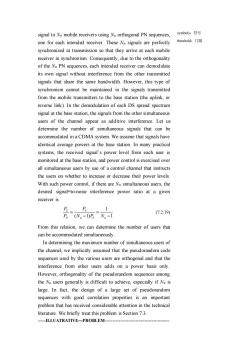
signal to Nu mobile receivers using Nir orthogonal PN sequences, symbols:符号 one for each intended receiver.These N signals are perfectly threshold::门限 synchronized at transmission so that they arrive at each mobile receiver in synchronism.Consequently,due to the orthogonality of the Ni PN sequences,each intended receiver can demodulate its own signal without interference from the other transmitted signals that share the same bandwidth.However,this type of synchronism cannot be maintained in the signals transmitted from the mobile transmitters to the base station (the uplink,or reverse link).In the demodulation of each DS spread spectrum signal at the base station,the signals from the other simultaneous users of the channel appear as additive interference.Let us determine the number of simultaneous signals that can be accommodated in a CDMA system.We assume that signals have identical average powers at the base station.In many practical systems,the received signal's power level from each user is monitored at the base station,and power control is exercised over all simultaneous users by use of a control channel that instructs the users on whether to increase or decrease their power levels. With such power control,if there are Nu simultaneous users,the desired signal=to-noise interference power ratio at a given receiver is 1 F,W-0E=N,- (7.2.19) From this relation,we can determine the number of users that can be accommodated simultaneously In determining the maximum number of simultaneous users of the channel,we implicitly assumed that the pseudorandom code sequences used by the various users are orthogonal and that the interference from other users adds on a power basis only. However,orthogonality of the pseudorandom sequences among the N users generally is difficult to achieve,especially if N is large.In fact,the design of a large set of pseudorandom sequences with good correlation properties is an important problem that has received considerable attention in the technical literature.We briefly treat this problem is Section 7.3. -ILLUATRATIVE-PROBLEM-
signal to Nu mobile receivers using Nu orthogonal PN sequences, one for each intended receiver. These Nu signals are perfectly synchronized at transmission so that they arrive at each mobile receiver in synchronism. Consequently, due to the orthogonality of the Nu PN sequences, each intended receiver can demodulate its own signal without interference from the other transmitted signals that share the same bandwidth. However, this type of synchronism cannot be maintained in the signals transmitted from the mobile transmitters to the base station (the uplink, or reverse link). In the demodulation of each DS spread spectrum signal at the base station, the signals from the other simultaneous users of the channel appear as additive interference. Let us determine the number of simultaneous signals that can be accommodated in a CDMA system. We assume that signals have identical average powers at the base station. In many practical systems, the received signal’s power level from each user is monitored at the base station, and power control is exercised over all simultaneous users by use of a control channel that instructs the users on whether to increase or decrease their power levels. With such power control, if there are Nu simultaneous users, the desired signal=to-noise interference power ratio at a given receiver is 1 ( 1) 1 S S N u S u P P P N P N = = − − (7.2.19) From this relation, we can determine the number of users that can be accommodated simultaneously. In determining the maximum number of simultaneous users of the channel, we implicitly assumed that the pseudorandom code sequences used by the various users are orthogonal and that the interference from other users adds on a power basis only. However, orthogonality of the pseudorandom sequences among the Nu users generally is difficult to achieve, especially if Nu is large. In fact, the design of a large set of pseudorandom sequences with good correlation properties is an important problem that has received considerable attention in the technical literature. We briefly treat this problem is Section 7.3. -ILLUATRATIVE—PROBLEM- symbols:符号 threshold:门限
按次数下载不扣除下载券;
注册用户24小时内重复下载只扣除一次;
顺序:VIP每日次数-->可用次数-->下载券;
- 《通信原理实验》课程电子教案(PPT讲稿)MATLAB与通信仿真(英文)Chapter 2 Analog Modulation(SSB – AM).ppt
- 《通信原理实验》课程电子教案(PPT讲稿)MATLAB与通信仿真(英文)Chapter 2 Analog Modulation(Conventional AM).ppt
- 《通信原理实验》课程电子教案(PPT讲稿)MATLAB与通信仿真(英文)Chapter 2 Analog Modulation(AM,Amplitude Modulation).ppt
- 《通信原理实验》课程电子教案(讲稿)MATLAB与通信仿真(英文)Chapter 1 Basic Matlab.doc
- 《通信原理实验》课程电子教案(PPT讲稿)MATLAB与通信仿真电子教案_第1章 matlab基础知识.ppt
- 《通信原理实验》课程电子教案(PPT讲稿)MATLAB与通信仿真电子教案_第3章 图形处理与simulink仿真.ppt
- 《通信原理实验》课程电子教案(PPT讲稿)MATLAB与通信仿真电子教案_第2章 matlab语言入门.ppt
- 《通信原理实验》课程电子教案(PPT讲稿)MATLAB与通信仿真电子教案_matlab在通信中的应用(模拟调制系统).ppt
- 《通信原理实验》课程电子教案(PPT讲稿)MATLAB与通信仿真电子教案_matlab在通信中的应用(模拟信号的数字传输).ppt
- 《通信原理实验》课程电子教案(PPT讲稿)MATLAB与通信仿真电子教案_matlab在通信中的应用(二进制基带系统).ppt
- 《通信原理实验》课程电子教案(PPT讲稿)MATLAB与通信仿真电子教案_matlab在通信中的应用(PSK频带传输系统).doc
- 《通信原理实验》课程电子教案(PPT讲稿)FPGA通信系统设计——第四讲 DDS信号发生器周期信号的傅里叶级数拟合.ppt
- 《通信原理实验》课程电子教案(讲稿)FPGA通信系统设计——第四讲 方波信号展开为傅里叶级数.doc
- 《通信原理实验》课程电子教案(讲稿)FPGA通信系统设计——第四讲 实验四 DDS信号发生器与周期函数的傅里叶级数拟合.doc
- 《通信原理实验》课程电子教案(讲稿)FPGA通信系统设计——第四讲 DDS信号发生器周期信号的傅里叶级数拟合.doc
- 《通信原理实验》课程电子教案(PPT讲稿)FPGA通信系统设计——第二讲 System Generator for DSP.ppt
- 《通信原理实验》课程电子教案(讲稿)FPGA通信系统设计——第二讲 实验二 Nexys 3实验板及设计软件.doc
- 《通信原理实验》课程电子教案(讲稿)FPGA通信系统设计——第三讲 实验三 DA芯片的型号及时序.pdf
- 《通信原理实验》课程电子教案(讲稿)FPGA通信系统设计——第三讲 实验三 DA芯片的型号及时序.doc
- 《通信原理实验》课程电子教案(PPT讲稿)FPGA通信系统设计——第一讲 XilinxFPGA介绍.ppt
- 《通信原理实验》课程电子教案(PPT讲稿)MATLAB与通信仿真(英文)Chapter 2 Analog Modulation(Frequency Modulation、Phase Modulation).ppt
- 《通信原理实验》课程电子教案(PPT讲稿)MATLAB与通信仿真(英文)Chapter 2 Transmitters and Receivers.ppt
- 《通信原理实验》课程电子教案(PPT讲稿)MATLAB与通信仿真(英文)Chapter 3 Analog-to-Digital Conversion(Preview、Measure of Information、Quantization).ppt
- 《通信原理实验》课程电子教案(PPT讲稿)MATLAB与通信仿真(英文)Chapter 3 Analog-to-Digital Conversion(Pulse Amplitude Modulation、Pulse Code Modulation).ppt
- 《通信原理实验》课程电子教案(PPT讲稿)MATLAB与通信仿真(英文)Chapter 4 Baseband Digital Transmission(Binary Signal Transmission).ppt
- 《通信原理实验》课程电子教案(PPT讲稿)MATLAB与通信仿真(英文)Chapter 4 Baseband Digital Transmission(Multiamplitude Signal Transmission).ppt
- 《通信原理实验》课程电子教案(PPT讲稿)MATLAB与通信仿真(英文)Chapter 4 Baseband Digital Transmission(Multidimensional Signals).ppt
- 《通信原理实验》课程电子教案(PPT讲稿)MATLAB与通信仿真(英文)Chapter 5Digital Transmission Through Bandlimited Channels.ppt
- 《通信原理实验》课程电子教案(PPT讲稿)MATLAB与通信仿真(英文)Chapter 6 Binary Modulated Bandpass Signaling(1/3).ppt
- 《通信原理实验》课程电子教案(PPT讲稿)MATLAB与通信仿真(英文)Chapter 6 Binary Modulated Bandpass Signaling(2/3).ppt
- 《通信原理实验》课程电子教案(PPT讲稿)MATLAB与通信仿真(英文)Chapter 6 Binary Modulated Bandpass Signaling(3/3).ppt
- 《通信原理实验》课程电子教案(PPT讲稿)Verilog HDL数字系统设计与综合实验——第01讲 HDL语言概述.ppt
- 《通信原理实验》课程电子教案(PPT讲稿)Verilog HDL数字系统设计与综合实验——第02讲 Verilog HDL语言基础.ppt
- 《通信原理实验》课程电子教案(PPT讲稿)Verilog HDL数字系统设计与综合实验——第03讲 门级与结构建模.ppt
- 《通信原理实验》课程电子教案(PPT讲稿)Verilog HDL数字系统设计与综合实验——第04讲 数据流建模.ppt
- 《通信原理实验》课程电子教案(PPT讲稿)Verilog HDL数字系统设计与综合实验——第05讲 行为建模(1/2).ppt
- 《通信原理实验》课程电子教案(PPT讲稿)Verilog HDL数字系统设计与综合实验——第06讲 行为建模(2/2).ppt
- 《通信原理实验》课程电子教案(PPT讲稿)Verilog HDL数字系统设计与综合实验——第07讲 综合建模与仿真.ppt
- 《通信原理实验》课程电子教案(PPT讲稿)Verilog HDL数字系统设计与综合实验——第08讲 可综合设计.ppt
- 《通信原理实验》课程电子教案(PPT讲稿)嵌入式系统设计实验——第1章 嵌入式系统概述.ppt
